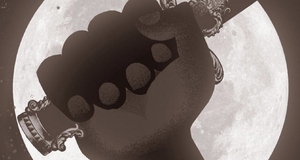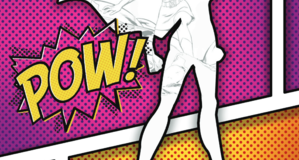Graphic Novels: Preparing for a Mulitmodal and Multiliterate WorldThe Future of LiteracyMilton Caniff, a cartoonist in the early twentieth century, insisted that comic strips were “a communication form rather than an art form” (as cited in McCloud, 2000, p. 27). As the image to word ratio steadily increases in documents of all kinds (Horn, 1999), it is clear that a new language – a graphic language – is emerging throughout the professional and academic community. Described by Hatfield (2005) as a “recent groundswell in multidisciplinary word/image studies” (p. 32), information design is a relatively new profession and field of study (Herrara, 2013; Horn, 1999). Born, according to Horn, “from the urgent needs of contemporary individuals and organizations to deal with complexity” (p. 28), information design takes on many of the tenets of the comics medium. Named accordingly for each discipline in which it is used, information design has been called, “information graphics,” “presentation graphics,” “scientific visualization,” “interface design,” “graphic recording,” “signage,” etc. (Horn, 1999, p. 17). No matter the name, each title practices “the art of organizing, selecting, optimizing and transforming complex data into easier, useful, and effective information with the intention to satisfy user needs and objectives according to a context” (Herrera, 2013, p. 6). These emerging professional specializations show how graphics as a medium of communication is not just an art form but a valuable and growing field of study. Horn (1999) describes this new visual language as a tight coupling of words and images. This coupling is so tight, he states, “you cannot remove the words or images or the shapes from a piece of visual language with out destroying or radically diminishing the meaning a reader can obtain from it” (p. 27). Through the use of graphic novels and the exploration of comics as a form of communication, Hatfield (2005) suggests, “we can work on establishing a much needed vocabulary for the study of hybrid texts, old and new, a vocabulary that will help us better understand the visual elements of literature as well as the possibilities of interartistic collaboration” (p. xiv). The comics1 medium, according to Carrier (2000), makes it “possible to deploy many different kinds of verbal information within storytelling visual images” (p. 2). Once recognized as a humble form of entertainment, aimed primarily at the young and uneducated (McCloud, 2000), visual language is now used in a wide range of professional and academic situations to assess a variety of problems and synthesize and communicate solutions (Herrera, 2013). As “neither the tools of visual arts or linguistics alone are enough to analyze visual language” (Horn, p. 28), this hybrid form of communication has become a topic of considerable study.The Comics Medium & Graphic Novels: Meeting the Needs of Changing LiteracyThough there is ample controversy and discussion about the medium of “comics,” there has been little agreement on defining, much less naming, this mode of communication. Comics is often used as a generic term to describe the general aesthetic features of the medium - the interplay between word and image (Versaci, 2007). As the literary medium has widened its scope, particularly over the past several decades however, many graphic artists/writers have come up with their own styles as well as terms and descriptions to define their practice. “So great is the diversity of what has been claimed as comics, or what is claimed today under diverse latitudes, that it has become almost impossible to retain any definitive criteria that is universally held to be true” (Groensteen, 2007, pp. 126). Since the early twentieth century comics publications world wide, under their various names, have experienced scrutiny by academics, government and the industry itself. Accused of a range of transgressions from being a vulgar, mediocre form of entertainment, capable of damaging the feeble minds of children (Groensteen, 2000) to debasing culture and lowering literacy (Groensteen, 2007), many graphic artists were forced to submit to the imposed and confining conventions of the industry. Comics’ relationship with humor, caricature and satire is one of the medium’s several handicaps, according to Groensteen (2000), in what was once (and in some countries, still is) known as paraliterature. These classifications lead, in part, to Will Eisner, the grandfather of the graphic novel (Fry & Fisher, 2006), coining the phrase “sequential art” as a replacement for “comics.” The term, as Witek (1989) points out, “has the advantage of avoiding the generic connotations of the word “comic” and sidestepping associations with the burlesque and the ridiculous” (p. 6). Since Eisner’s “sequential art,” a plethora of terms for the medium and its conceptualizations have emerged. What is a Graphic Novel?A loosely named offshoot of the comic book (Hatfield, 2005), the graphic novel has a slightly more narrowed scope, yet nearly as much disagreement over its name and definition as the comics medium. In fact, a profusion of descriptions exist. Some proponents of the field use the term graphic novel simply as comics in longer book form (Versaci, 2007), while others have more specific criteria, most notable of which is length (Hatfield, 2005; McCloud, 2000, Schwarz, 2000). Though it is not only length that makes the difference. According to McCloud (2000), the substance of the narrative is of equal importance. “A single panel – even a silent one – may speak volumes in one book while whole pages of another tell us very little” (2000, p. 34). According to Daniels and Zemelman (as cited in Christensen, 2006), the graphic novels used in classrooms should have: content that is important […]; people who we can care about; a narrative structure or chronological line; places we can visualize; danger, conflicts, risks, or choices; value, moral, ethical or political dimensions; [and] ideas that reasonable people can debate, dispute, or disagree about (p. 228). Following depth, according to McCloud (2000), is breadth. Though he claims that breadth is missing from the literary form, since 2009, the New York Times has listed three categories of best selling graphic books: hardcover, paperback and manga. The June 2014 lists cover a range of genres from super heroes, sci-fi, and adaptations of literary fiction to historical and autobiographic non-fiction (New York Times, 2014). Some academics in the field (Gravett, 2005; Lavin, 1998) also contend that graphic novels should be original stories rather than graphic adaptations of previously written literature while others (Chun, 2009; Schwarz, 2002) include adaptations in their criteria. The term graphic novel is also a “topic of dispute between ‘graphic novelists’ themselves, some of whom reject the term outright” (Gravett, 2005, p. 8). Michael Nicoll Yahgulanaas, for example, an artist from Haida Gwaii, the Indigenous lands off the West Coast of British Columbia, coined the term “Haida Manga” for his graphic narratives. He chose the term ‘manga’ from the genre of Japanese graphic narratives to “consciously reject aligning his tales with mainstream North American and European comic cultures” (Yahgulanaas, 2011, p. 5). This disagreement on an exact name or definition for graphic novels, may serve as a reflection of the content of the medium itself. Due to the diversity of production and interpretation of this newly recognised form of literature, there simply can’t be just one name or one definition. In this paper, the term “comics” will refer to the form of medium while the term “graphic novel” will refer to novel-length books, which use the comic form to tell a narrative of substance.Continued on Next Page » Suggested Reading from Inquiries Journal
Inquiries Journal provides undergraduate and graduate students around the world a platform for the wide dissemination of academic work over a range of core disciplines. Representing the work of students from hundreds of institutions around the globe, Inquiries Journal's large database of academic articles is completely free. Learn more | Blog | Submit Latest in Education |


















